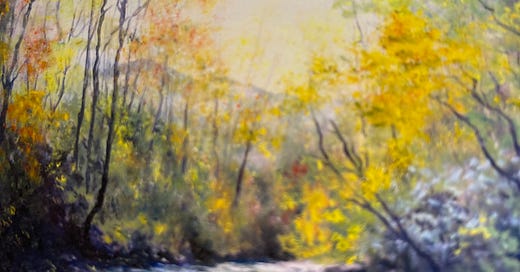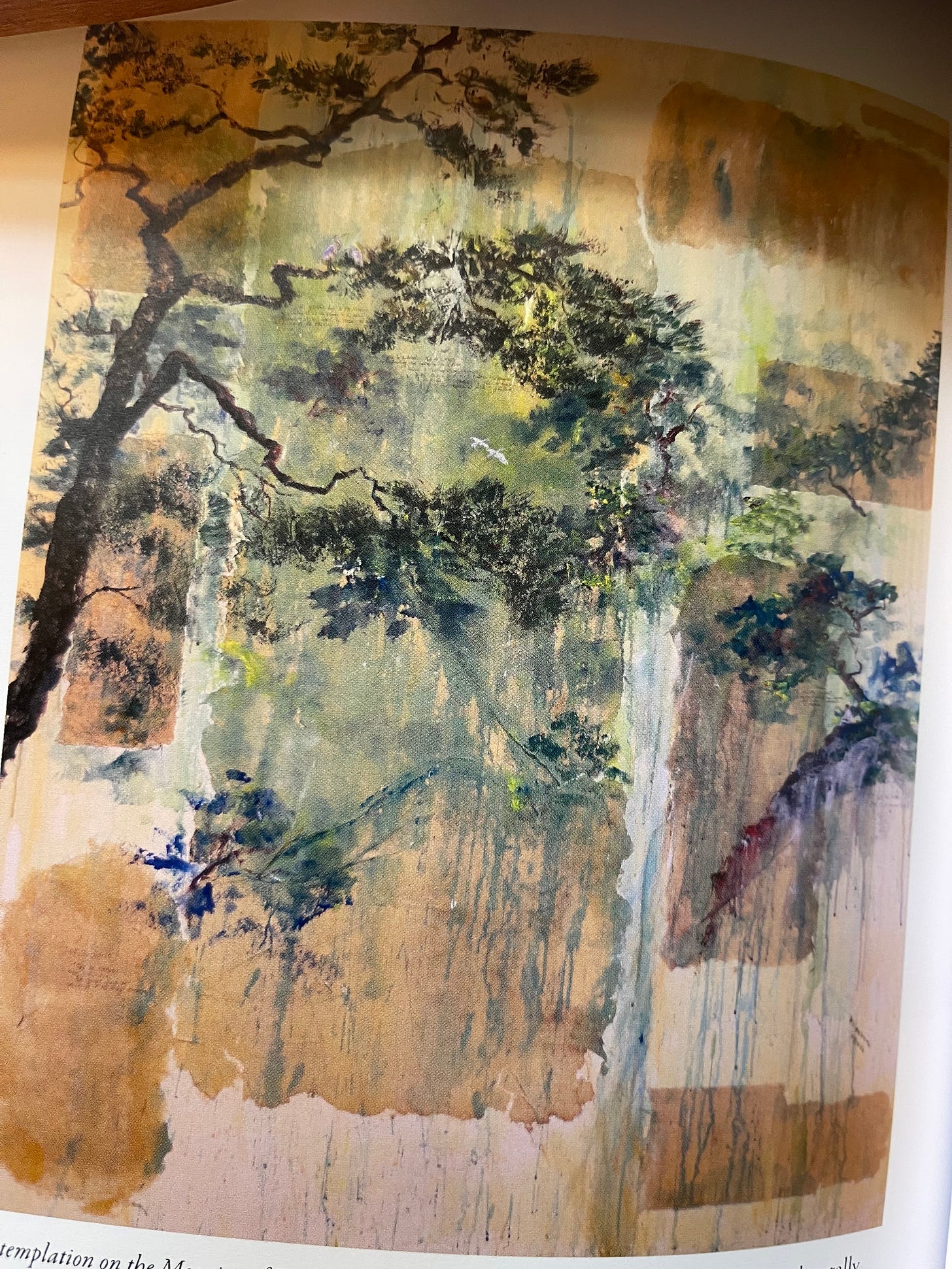Making patient poetry from our mountains
How George Ellison found a home for his family and art
Downstream, by Elizabeth Ellison
George and Elizabeth Ellison found more than a place to call home nearly 50 years ago while wandering the Great Smoky Mountains National Park. Following a creek up from the Tuckasegee River, the young couple came to a gate guarding a parcel of private land— a cove with an abandoned shack and a 50-acre farm.
Elizabeth located the property owner in Bryson City the next day, who seemed skeptical. “Why would anyone want to live there without electricity,” she remembered. “I think he thought we were hippies who would be growing marijuana. He offered to rent us the house for $30 a month or the land and the house for $35.”
They moved in the day after Independence Day, 1976, with their three children and found a new freedom to write their books and create art.
George died at age 81 in 2023 after an illustrious career as a naturalist and writer.
But now Elizabeth and daughter, Quintin, have teamed up to preserve George’s rich poetry in “Land of Blue Shadows: Mountain Life in Verse & View.” Accompanied with Elizabeth’s watercolors and oils and Quentin’s accomplished photographs, the book makes a vital contribution to our local lore and a continuation of the Ellison legacy that has found deep art in our deep mountains.
Bounded on three sides by the Great Smokies national park, Ellison studied the woods growing in his cove and the rush of water down Lands Creek from the windows of his office for nearly half a century. "One of my trusted sayings is that the better you have a clear idea of where you are, the better you know who you are," Ellison told me in an interview I did for the Asheville Citizen-Times in 2016.
He shared those insights some 1,500 Nature Journal columns illustrated by Elizabeth and printed weekly for 30 years in the Asheville Citizen-Times.
As a copy editor, I remember seeing George’s column arrive faithfully on deadline, accompanied by Elizabeth’s wonderful postcard sized watercolors of the bird or plant or whatever George was writing about that week. And I counted Quinten as a colleague at the Citizen-Times for years.
Staying in one place so long, the Ellisons learned and lived in the ever changing seasons of an ancient landscape.
“These are the oldest mountains that have maintained their integrity. We’re living here in a special time when they are at a mature stage with the greatest biodiversity,” Ellison told me. “You can go to Arizona and be enthralled by the landscape, but for hundreds of miles it will look the same. Here in this cove, I can walk around and find five or six different ecosystems from the creek’s edge to a specific stand of oaks.”
A Russian geologist once said that the Appalachians are the most elegant mountain chain in the world, according to Ellison. “They’re not fierce and threatening like the Rockies or the Himalayas. And there’s something in that maturity that calls to us.”
Growing up in Danville, Virginia, Ellison had two dreams as a boy. “First, I wanted to pitch for the Brooklyn Dodgers. After I figured I wasn’t that good a pitcher, I wanted to be a writer. I thought sports writing might be fun.”
In the 1960s, he went to UNC Chapel Hill on a football scholarship but tore up his knee in a game against Ohio State University. With his athletic dreams ended, he focused on literature and went on to graduate school at the University of South Carolina.
Ellison was an English professor at Mississippi State University, specializing in Southern regional writers, including Horace Kephart. At an academic conference, he bumped into an editor from the University of Tennessee Press who wanted Ellison to write an introduction to Kephart’s 1913 classic “Our Southern Highlanders."
He got $250 for the essay, which he used to buy a horse for Elizabeth. But he started making trips to the Smokies for his research into Kephart.
An alcoholic librarian who suffered a nervous breakdown, Kephart left his wife and children in St. Louis in 1904. He retreated to “Back of Beyond,” the remote reaches of the Smokies to recuperate, but would wind up spending the rest of life in the Bryson City area. Kephart was famed for his “Camping and Woodcraft” handbook, familiar to generations of Boy Scouts. And based on his years on Hazel Creek, Kephart would write “Our Southern Highlanders,” his study of the unique mountaineer culture.
Kephart went on to champion the creation of a national park to protect the landscape he so loved as well as routing the Appalachian Trail through the Smokies. Kephart died in a car crash in 1931.
He’s the writer most closely identified with the Great Smoky Mountains National Park, and perhaps the writer with the greatest national reputation after Thomas Wolfe,” Ellison suggested. “As a writer, I found it just to be hell of a story.”
Ellison worked with Janet McCue, a librarian at Cornell University, where Kephart was trained as a librarian. They co-authored “Back of Beyond” the first comprehensive biography of Kephart, which won the Thomas Wolfe Literary Award.
Contemplation on the Meaning of Tao, Elizabeth Ellison
While George pursued his dreams to be a writer, Elizabeth has always worked as an artist. “I’ve never had any other career.”
Elizabeth moved her studio out to Bryson City’s Main Street in 1986, looking for more room to paint her oil and watercolor studies of the landscape, wildlife and plants. Her gallery has become a Bryson City institution, helping attract tourists to the Swain County seat. In 2013, she and George were named Bryson City’s Business Citizens of the year. “Why?” Elizabeth grinned. “Because we stuck it out. George and I have always supported each other.”
The Ellisons replaced their original farmhouse for another home back in the 1990s when they finally purchased their land outright. A friend of Ellison’s had bought some old Fontana Village housing, designed by a Boston architect to be rolled off trains to provide homes for workers building the Tennessee Valley Authority dam during World War II.
Ellison bought the house for $700 and had it moved to the cove. “This might be the last $700 house you ever see,” he tapped the sturdy wall of his haven.
In addition to forewords to Kephart's work and James Mooney's "Myths of the Cherokee and Sacred Formula of the Cherokee," Ellison published "Mountain Passages," “Blue Ridge Nature Journal,” and two volumes of “High Vistas: An Anthology of Nature Writing in Western North Carolina and the Great Smoky Mountains.” And a previous collection of poetry “Permanent Camp,” teaming up with Elizabeth and her accompanying art.
Ellison would turn more from prose toward poetry in later years as he learned to adapt to Parkinson’s disease, the neurological disorder that caused him to see his world differently.
He let the sentences and images flow, like the water he keeps watching from his window, in the changing seasons along Lands Creek. Here’s his tribute to his homescape.
Land’s Creek
The Creek makes its own way
Casting serpentine bends
That grasp worn stone
ever changing
never the same
taking its time
moving along
from where it’s been
to where it’s going.
In reading through her father’s poems to create the book “Land of Blue Shadows, Quintin said she could hear her father’s voice clear as day again.
Points of Light
Try to remember when we meet
& I have little or nothing to say that
doesn’t mean I’m neither here nor there.
Look for the random points of light in the
shadows of my eyes. Listen to the rhythms
in these lines beating just for you.
In an essay, Ellison once wrote about the physical pull of their beloved land, as they were driving home through Newport, Tennessee, catching a glimpse of the Smokies in the distance. “We were entering the gravitational field big mountains cast—you can feel them in your bones as they first emerge on the far horizon; it doesn’t matter which direction you’re coming from. It’s home — it is, as they say, ‘in the mountain’ — and who would want to be in any other place for very long?”
Since George’s death, they’ve created a conservancy to keep their pocket of land protected for the future Now Elizabeth follows their old trails up on the ridge and puts choice rocks on the cairn where George’s ashes lay.
The man and his poetry and his voice remain like his beloved mountains.
Elizabeth and Quintin Ellison will be talking about “Land of Blue Shadows” 1-3 pm. Saturday, June 21 at Blue Ridge Books in Waynesville NC. Don’t miss them if you’re in the area.





So good to hear your voice in this writing, Dale, and to remember George Ellison and his columns which were always a highlight in the Citizen-Times.
Darcy
Dale, this is lovely. Thank you for your writing. Judy Morris